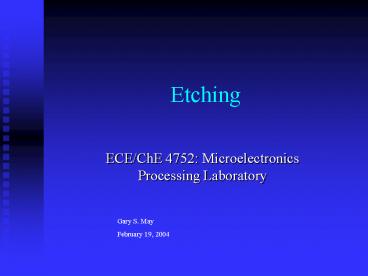Etching PowerPoint PPT Presentation
1 / 21
Title: Etching
1
Etching
- ECE/ChE 4752 Microelectronics Processing
Laboratory
Gary S. May February 19, 2004
2
Outline
- Introduction
- Wet Chemical Etching
- Plasma Etching
3
Definition
- Recall Photolithography process of
transferring patterns (on masks) onto a thin
layer of photoresist - Photoresist patterns must be transferred once
more onto the underlying layers to produce
circuit features - Pattern transfer accomplished by selectively
etching unmasked portions of a layer
4
Etching Hierarchy
5
Outline
- Introduction
- Wet Chemical Etching
- Plasma Etching
6
Uses
- Prior to thermal oxidation or epitaxial growth,
wafers are chemically cleaned to remove
contamination - Especially suitable for blanket etches (i.e.,
over the whole wafer surface) of polysilicon,
oxide, nitride, metals, and III-V compounds.
7
Mechanism
- Reactants transported by diffusion to surface
- Reactions occur at surface
- Products from surface removed by diffusion
8
Uniformity
- Equality of vertical etch rates at different
sites on the wafer surface - This is actually non-uniformity
- Alternative definitions
- s/m
9
Silicon Etching
- Most etchants are mixtures of HNO3 and HF in
water or acetic acid (CH3COOH). - HNO3 oxidizes silicon to form an SiO2 layer
- Si 4HNO3 ? SiO2 2H2O 4NO2
- HF is used to dissolve the SiO2 layer
- SiO2 6HF ? H2SiF6 2H2O
- Water can be used as a diluent for this etchant,
but acetic acid is preferred.
10
Orientation-Dependent Etching
- Some etchants dissolve a certain crystal plane of
Si faster than another plane - For Si, the (111) plane has more available bonds
per unit area than the (110) and (100) planes - Therefore, etch rate is slower for the (111)
plane.
11
KOH Etching
- KOH is an orientation-dependent etchant for Si.
- Solution with 19 wt KOH in deionized water at
80 oC removes the (100) plane at a much higher
rate than the (110) and (111) planes ratio of
etch rates for (100)(110)(111) planes
100161.
12
SiO2 Etching
- Commonly etched in a dilute solution of HF with
or without NH4F - Adding NH4F is called a buffered HF solution
(BHF), also called buffered-oxide-etch (BOE) - Reaction for SiO2 etching
- SiO2 6HF ? H2SiF6 2H2O
- SiO2 can also be etched in vapor-phase HF.
13
Outline
- Introduction
- Wet Chemical Etching
- Plasma Etching
14
Anisotropy
- Vertical features are desirable to increase
circuit density. - Quantitatively
- where RL lateral etch rate, RV vertical etch
rate
15
Plasma Fundamentals
- Plasma ionized gas composed of equal numbers of
positive and negative charges and a different
number of unionized molecules - Produced when electric field is applied to a gas,
causing gas to break down and become ionized - Initiated by free electrons that gain kinetic
energy from electric field, collide with gas
molecules, and lose energy. - Energy transferred causes the gas molecules to be
ionized (i.e., to free electrons). - Free electrons gain kinetic energy from the
field, and the process continues.
16
Plasma Etching
- Plasma etching - chemical reaction combined with
physical ion bombardment - Other names
- ion milling
- sputter etching
- reactive ion etching
- reactive ion beam etching
- First explored as a cheaper alternative to wet
solvent resist stripping in 1960s and 70s
17
Etch Equipment
18
Etch Mechanism
- Etchant species generated in plasma.
- Reactant transported by diffusion to surface.
- Reactant adsorbed on the surface.
- Chemical reaction (along with ion bombardment)
forms volatile compounds. - Compounds desorbed from surface, diffused into
the bulk gas, and pumped out by vacuum system.
19
End-Point Control
- Dry etching has less etch selectivity than wet.
- Plasma reactor must be equipped with a monitor
that indicates when the etching process is to be
terminated (end point detection system). - Laser interferometry is used to determine the end
point.
20
Laser Interferometry
- Intensity of laser light reflected off thin film
surface oscillates. - Period of the oscillation related to change in
film thickness - where Dd change in film thickness, l is the
wavelength, and is the refractive index
21
Interferometry Example
- Typical signal from a silicide/polycrystalline Si
gate etch - Dd for polysilicon 80 nm (measured by using a
He-Ne laser with l 632.8 nm)

